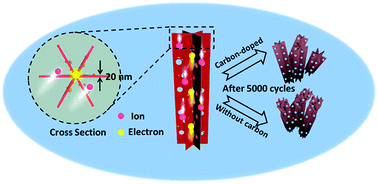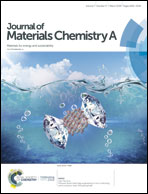Hexagonal prism arrays constructed using ultrathin porous nanoflakes of carbon doped mixed-valence Co–Mn–Fe phosphides for ultrahigh areal capacitance and remarkable cycling stability†
Abstract
One of the challenges with supercapacitors is achieving ultrahigh specific capacitance by maximizing utilization of active materials while assuring their cycling stability. Herein, we report a significant advance toward the design and fabrication of novel hierarchical hexagonal prism arrays constructed using carbon doped mixed-valence Co–Mn–Fe multi-metallic phosphide ultrathin porous nanoflakes via an ion-induced growth of the precursor followed by phosphorization. Each hexagonal prism features an architecture consisting of six symmetrically distributed and interlaced nanoflakes each with a thickness of ∼15 nm and many pores of ∼10 nm diameter. New insights into the Fe2+ induced anisotropic growth of Co–Mn oxide hydroxides and partial conversion of Co2+ into Co3+ leading to enhanced electrical conductivity are proposed. Such a Co–Fe–Mn phosphide electrode shows a specific areal capacitance reaching 4.36 F cm−2 (at 2 A cm−2), much higher than those for bimetallic phosphides. The high areal capacitance is attributed to the unique architecture lowering flow resistance of the electrolyte wetting process, abundant mixed-valence states of metals and active sites/interfaces, and enhanced electrical conductivity. The carbon doping substantially improves the cycling stability because it effectively buffers the strain/volume expansion during fast faradaic reactions. Especially even at a high current density of 20 mA cm−2, 100% capacitance retention can be achieved after 5000 cycles. An asymmetric device based on such an electrode delivers an energy density of 53.2 W h kg−1 (at 399.7 W kg−1) which is higher than many previously reported values.



 Please wait while we load your content...
Please wait while we load your content...